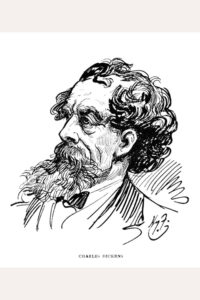
Three Ghost Stories
“Halloa! Below there!”
When he heard a voice thus calling to him, he was standing at the door of his box, with a flag in his hand, furled round its short pole. One would have thought, considering the nature of the ground, that he could not have doubted from what quarter the voice came; but instead of looking up to where I stood on the top of the steep cutting nearly over his head, he turned himself about, and looked down the Line. There was something remarkable in his manner of doing so, though I could not have said for my life what. But I know it was remarkable enough to attract my notice, even though his figure was foreshortened and shadowed, down in the deep trench, and mine was high above him, so steeped in the glow of an angry sunset, that I had shaded my eyes with my hand before I saw him at all.
“Halloa! Below!”
From looking down the Line, he turned himself about again, and, raising his eyes, saw my figure high above him.
“Is there any path by which I can come down and speak to you?”
He looked up at me without replying, and I looked down at him without pressing him too soon with a repetition of my idle question. Just then there came a vague vibration in the earth and air, quickly changing into a violent pulsation and an oncoming rush that caused me to start back, as though it had force to draw me down. When such vapor as rose to my height from this rapid train had passed me, and was skimming away over the landscape, I looked down again and saw him refurling the flag he had shown while the train went by.
I repeated my inquiry. After a pause, during which he seemed to regard me with fixed attention, he motioned with his rolled-up flag towards a point on my level, some two or three hundred yards distant. I called down to him, “All right!” and made for that point. There, by dint of looking closely about me, I found a rough zigzag descending path notched out, which I followed.
Read or download Book
Charles Dickens
Charles John Huffam Dickens (7 February 1812 – 9 June 1870) was an English novelist and social critic who created some of the world’s best-known fictional characters and is regarded by many as the greatest novelist of the Victorian era.
Biography.
His works enjoyed unprecedented popularity during his lifetime and, by the 20th century, critics and scholars had recognized him as a literary genius. His novels and short stories are widely read today.
Born in Portsmouth, Dickens left school at the age of 12 to work in a boot-blacking factory when his father John was incarcerated in a debtors’ prison. After three years he returned to school before he began his literary career as a journalist. Dickens edited a weekly journal for 20 years, wrote 15 novels, five novellas, hundreds of short stories and non-fiction articles, lectured and performed readings extensively, was an indefatigable letter writer, and campaigned vigorously for children’s rights, for education, and other social reforms. Dickens’s literary success began with the 1836 serial publication of The Pickwick Papers, a publishing phenomenon—thanks largely to the introduction of the character Sam Weller in the fourth episode—that sparked Pickwick merchandise and spin-offs. Within a few years, Dickens had become an international literary celebrity, famous for his humor, satire, and keen observation of character and society. His novels, most of them published in monthly or weekly installments, pioneered the serial publication of narrative fiction, which became the dominant Victorian mode for novel publication. Cliffhanger’s endings in his serial publications kept readers in suspense.
The installment format allowed Dickens to evaluate his audience’s reaction, and he often modified his plot and character development based on such feedback. For example, when his wife’s chiropodist expressed distress at the way Miss Mowcher in David Copperfield seemed to reflect her disabilities, Dickens improved the character with positive features. His plots were carefully constructed and he often wove elements from topical events into his narratives. Masses of the illiterate poor would individually pay a half penny to have each new monthly episode read to them, opening up and inspiring a new class of readers. His 1843 novella A Christmas Carol remains especially popular and continues to inspire adaptations in every creative medium. Oliver Twist and Great Expectations are also frequently adapted and, like many of his novels, evoke images of early Victorian London.
His 1859 novel A Tale of Two Cities (set in London and Paris) is his best-known work of historical fiction. The most celebrity of his era, he undertook, in response to public demand, a series of public reading tours in the later part of his career. The term Dickensian is used to describe something reminiscent of Dickens and his writings, such as poor social or working conditions, or comically repulsive characters.






